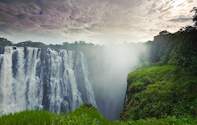
When in 1851 David Livingstone first arrived in Makololo territory, what we now call Chobe, in the company of the hunter William Oswell, he seemed to ignore stories of a great waterfall that Chief Sebituane of the local tribe referred to as "the smoke that thunders" (mosi-oa-tunya).
He did not continue further to see the magnificent river that created the falls, which is rather odd for the most celebrated explorer of the time.
It is a commonly perpetuated fiction that the great waterfall was first discovered by David Livingstone in 1855. In all likelihood, he wasn't even the first European to see them. The strongest claimant to that honour is the Portuguese ivory trader Antonio da Silva Porto who had been travelling in the area since 1848.
Who Saw Victoria Falls First
When in 1851 Livingstone came in sight of the famous spray plume (but for reasons obscure decided not to press on the extra few miles to the falls themselves), da Silva Porto visited his camp and gave him a gift of preserved fruit, fresh bread, cabbages and two Dutch cheeses.
It might well have been this outward display of extravagance that offended the parsimonious and abstemious Livingstone, (who denied his own expedition members such "luxuries" as tea, sugar, jam and spirits) as in his diary he refers to the friendly Portuguese trader only in passing and then as a half-caste.
Next to beat him to this grand geographical prize was likely the Hungarian explorer Lazslo Magyar. He waited around the falls for a week hoping for the invitation to visit Livingstone's upstream camp but in vain.
The family of hunter Henry Hartley claimed their man had seen the falls back in 1848. This was based on a story told by one of Hartley's gun bearers, Cresjan, who recalled a cataract with rainbows and drenching spray.
Then again the Batoka, or Tonga people who have lived in the Zambezi valley for many centuries, clearly knew about the great chasm and its billowing plume of spray in their midst, since it has been the source of many myths handed down through generations.
David Livingstone's Discovery
We do have to wonder why Livingstone delayed getting to the falls for so long. By the time he did, he was on his second expedition into the south-central African interior and was by then the most famous explorer in the British Empire.
Read more about David Livingstone's history and the journey that led him to the discovery of the mighty Victoria Falls.

 David Livingstone epitomised the spirit of colonial exploration and spent 33 years travelling through Africa....
David Livingstone epitomised the spirit of colonial exploration and spent 33 years travelling through Africa....